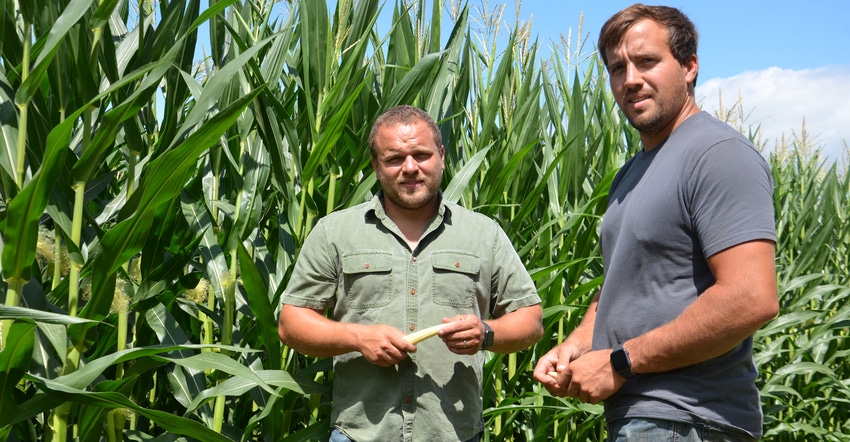
How do you farm if you have primarily rolling soils, labor is tight, and you have manure available? If you’re brothers Michael and Kelsey Gettelfinger, Washington County, Ind., you no-till, use cover crops and manage manure as a resource. The result is a sustainable, efficient crop production system that keeps soil out of waterways.
“We no-till about 90% to 95% of the time,” Kelsey explains. “If we didn’t, we would have real issues with soil erosion. We also plant cover crops on everything, if possible. Cover crops help control soil erosion.”
Michael notes that sometimes on river bottoms, they opt for a pass with a vertical-tillage tool. Sometimes, they run it after applying poultry litter, too.
Build the farm
Michael worked as a mechanic for Jacobi Sales in Palmyra, Ind., after graduating from West Washington High School. When their father, Steve, died, Michael began farming. “Having experience as a mechanic helps now,” he says. “We do most of our own mechanical work.”
Michael purchased 230 acres in 2011 and built three poultry houses in 2012. At the time, he produced broilers for a large corporation. After Kelsey returned home from Purdue University, where he majored in agronomy, he and Michael became farming partners.
Starting with a relatively small acreage base, they’ve rented more land over time. In 2014, they added three more chicken houses. Then in 2019, they made a major shift, from raising broilers to raising laying hens for River View Farms, Orleans.
“Today we have enough poultry litter for about 2,500 acres per year,” Michael says. “We can use about half of it ourselves and sell the rest.”
Build the soil
Kelsey has put his agronomic knowledge and connections to work. The brothers rely on Nicholson Consulting, Greencastle, Ind., for soil testing and soil fertility recommendations. Kelsey met Matt Stine, an agronomist with Nicholson, at Purdue.
“They’ve helped us determine how to best utilize our poultry litter, and how to make sure we have the right soil fertility levels in each field,” Michael says. By 2021, they shouldn’t need to purchase commercial fertilizer, except nitrogen for corn.
“Cover crops are helping build our soils, too,” Kelsey notes. “And with cover crops growing on fields where poultry litter was applied, they help hold nutrients from the manure, so they don’t leach or run off.”
Cereal rye is one of the Gettelfingers’ staples as a cover crop. “The trick is terminating it in the spring before it gets too tall,” Michael explains. “Our goal now is to control it relatively early in the spring, so we don’t have issues when we plant into it.
“If weather doesn’t cooperate and it gets very tall, we plant into it green. We don’t want to kill very tall rye and then try to plant into a mat. So far, we’ve been successful when we’ve planted green.”
Kelsey adds that they’ve tried other cover crops, including oats and crimson clover, with some success.
“Crimson clover works best if you can let it grow in the spring to get value from spring growth,” he says. “We seed it on wetter fields where we will plant last. That gives us time to let it grow longer.”
The Indiana Association of Soil and Water Conservation Districts recognized the Gettelfinger brothers as Conservation Farmers of the Year at its 2020 convention. The award is sponsored by Indiana Farm Bureau Inc.
About the Author(s)
You May Also Like




